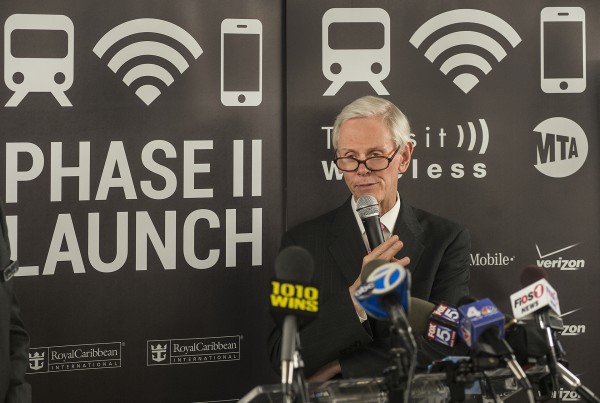
William Wheeler, director of special project development and planning at the MTA, last week announced the completion of Phase II of the agency’s subway Wi-Fi program.
Photo Courtesy MTA/Patrick Cashin
Metropolitan Transportation Authority officials, along with Transit Wireless executives, last week outside the Court Square subway station in Long Island City announced the completion of the second phase of the wireless and Wi-Fi network build-out, a “major expansion” of the communication services in more stations in Queens and Manhattan.
Phase II extended underground connectivity to 29 borough stations, including the hubs at Jackson Heights/Roosevelt Avenue, Jamaica Center, and Court Square. A total of 76 city stations and 47 million monthly riders are now connected.
“Bringing wireless service into our subway system is the latest milestone in the MTA’s effort to use technology to improve the service we provide for our customers,” MTA Chairman Thomas Prendergast said.
As the underground network continues to expand, MTA officials indicated that one of the most important benefits for customers is the ability to make E911 calls when needed. The network enables emergency dispatchers to know if a call is being placed from below ground and the approximate location of the caller. The network will also give MTA employees and first responders enhanced communications capability in an emergency. Additionally, the wireless service allows underground business owners and contractors to stay connected in a unique way.
Another initiative that’s part of the plan is the deployment of Help Point Intercoms. Created specifically for the subway environment, the Help Point Intercom is designed to be an easily recognizable communications tool for customers who need to either report an emergency or ask for travel directions. The units feature a bright blue beacon light that will pulse when the unit is in action. This will help alert first responders in case there is an injured or sick customer at that location.
The agency indicated that the completion of Phases I and II is part of seven phases to wire all 277 underground stations by 2017; and work has already begun to bring another 39 stations online by spring 2015. Phase III of the project will include the Flushing Main Street station, as well as stations in lower Manhattan, West Harlem and Washington Heights. Major stations in Phase III include the Fulton Street station, 125th Street station and the new 34th Street 7-train station when it opens next year.
“Adding and improving wireless service at more subway stations provides a much-anticipated boost to riders’ experience in one of the world’s busiest and oldest subway systems, while offering an added level of security,” Gov. Andrew Cuomo said in a statement. “A more stable network below ground ensures that riders and first responders can seamlessly communicate in events of emergency, which is essential in a system that carries millions of passengers every day.”
By Michael V. Cusenza
